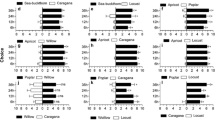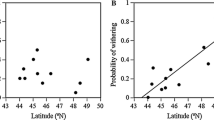Summary
As a species, the promethea silkmoth, Callosamia promethea (Saturniidae: Lepidoptera) exhibits a wide host range on 6–10 families of plants, although specific populations are known to have local foodplant favorites. We tested the hypothesis that larvae from a particular host plant lineage would show physiological adaptations to this host compared with larvae from other host plant lineages. We found no evidence that larval survival and growth was any better for larvae fed the natural plant of the parental population than for larvae from other host lineages. These natural host lineages include: black cherry (Prunus serotina Ehrh.), tuliptree (Liriodendron tulipifera L.), sassafras (Sassafras albidum (Nutt.) Nees) and spicebush (Lindera benzoin (L.) Blume). The only apparent manifestation of physiological specialization was the inability of tuliptree lineages of C. promethea to survive on paper birch (Betula papyrifera Marsh), although this may reflect the geographical pattern of adaptation to birch, rather than a negative correlation with adaptation to tuliptree. These results suggest that for C. promethea larvae, growth performance and survival is primarily influenced by plant nutritional quality, rather than physiological adaptations to the locally preferred host plant.
Similar content being viewed by others
References
Atsatt PR (1981) Lycaenid butterflies and ants: selection for enemy-free space. Am Nat 188: 638–654
Bernays E, Graham M (1988) On the evolution of host specificity in phytophagous arthropods. Ecology 69:886–892
Diehl SR, Bush GL (1984) An evolutionary and applied perspective of insect biotypes. Ann Rev Entomol 29:471–504
Ferguson DC (1972) Bombycoidea, Saturniidae (in part) In: R.B. Dominick (ed) The Moths of America North of Mexico, Fasc. 20.2B, E.W. Classey, Ltd. Middlesex, England
Fox LR, Morrow PA (1981) Specialization: Species property or local phenomenon? Science 211:887–893
Futuyma DJ, Moreno G (1988) The evolution of ecological specialization. Annu Rev Ecol Syst 19: 207–233
Futuyma DJ, Peterson SC (1985) Genetic variation in the use of resources by insects. Ann Rev Entomol 30: 217–238
Gilbert LE (1979) Development of theory in the analysis of insect-plant interactions. In: Horn D, Mitchell R, Stairs G (eds), Analysis of ecological systems. Ohio State University Press, Columbus, OH, pp 117–154
Hanson FE (1976) Comparative studies on induction of food choice preferences in Lepidoptera larvae. In: Jermy T (ed) Symp Biol Hung 16:71–77
Haskins CP, Haskins EF (1958) Note on the inheritance and behavior patterns for food selection and cocoon spinning in F1 hybrids of Callosamia promethea x C. angulifera. Behavior 13:89–95
Mattson WJ, Scriber JM (1987) Nutritional ecology of insect folivores of woody plants: Water, nitrogen, fiber, and mineral considerations. In: Slansky F Jr, Rodriguez JG (eds) Nutritional ecology of insects, mites and spiders Wiley, N.Y., pp 105–146
Palo RT (1984) Distribution of birch (Betula spp.), willow (Salix spp.), and poplar (Populus spp.) secondary metabolites and their potential role as chemical defense against herbivores. J Chem Ecol 10:499–520
Peigler RS (1976) Observations in host plant relationships and larval nutrition in Callosamia (Saturniidae). J Lepid Soc 30:184–187
Peigler RS (1977) Parasitism of Callosamia. J Ga Entomol Soc 12:111–114
Peigler RS (1980) Demonstration of reproductive isolating mechanisms in Callosamia (Saturniidae) by artificial hybridization. J Res Lepid 19:72–81
Scriber JM (1983) The evolution of feeding specialization physiological efficiency, and host races. In: Denno RF, McClure MS (eds) Variable plants and herbivores in natural and managed systems. Academic Press, New York, pp 373–412
Scriber JM (1984) Insect/Plant Interactions—Host plant suitability. In: Bell W, Carde R (eds) The chemical ecology of insects. Chapman and Hall, London, pp 159–202
Scriber JM (1986) Origins of the regional feeding abilities in the tiger swallowtail butterfly: ecological monophagy and the Papilio glaucus australis subspecies in Florida. Oecologia 71:94–103
Scriber JM, Feeny PP (1979) The growth of herbivorous caterpillars in relation to degree of feeding specialization and to growth form of their foodplants (Lepidoptera: Papilionidae and Bombycoidea). Ecology 60:829–850
Scriber JM, Hainze J (1987) Geographic variation in host utilization and the development of insect outbreaks. In: Barbosa P, Schultz JC (eds) Insect outbreaks: Ecological and evolutionary process. Academic Press, New York, pp 433–468
Scriber JM, Slansky F Jr (1981) The nutritional ecology of immature insects. Annu Rev Entomol 26:183–211
Scriber JM, Hsia MTS, Sunarjo P, Lindroth R (1987) Allelochemicals as determinants of insect damage across the North American continent: biotypes and biogeography. In: Waller G (ed) Allelochemicals: Their role in agriculture and forestry. Amer Chem Soc, Washington, DC (Symposium Series # 330), pp 339–448
Smiley J (1978) Plant chemistry and the evolution of host specificity: New evidence from Heliconius and Passaflora. Science 201:745–747
Snedecor GW, Cochran WG (1967) Statistical methods. Iowa State Univ Press Ames, IA
Thompson JN (1988) Evolutionary ecology of the relationship between oviposition preference and performance of offspring in phytophagous insects. Entomol Expt Appl 47:3–14
Wagner WH, Hansen MK, Mayfield MR (1981) True and false foodplants of Callosamia promethea (Lepidoptera: Saturniidae) in southern Michigan. Great Lakes Entomol 14:159–165
Waldbauer GP (1968) The consumption and utilization of food insects. Adv Insect Physiol 5:229–288
Waldbauer GP, Sternberg JG (1982) Cocoons of Callosamia promethea (Saturniidae): adaptive significance of differences in mode of attachment to the host tree. J Lepidopt Soc 36:192–199
Winer BJ (1962) Statistical principals in experimental design. McGraw-Hill, NY
Author information
Authors and Affiliations
Rights and permissions
About this article
Cite this article
Scriber, J.M., Potter, J. & Johnson, K. Lack of physiological improvement in performance of Callosamia promethea larvae on local host plant favorites. Oecologia 86, 232–235 (1991). https://doi.org/10.1007/BF00317535
Received:
Accepted:
Issue Date:
DOI: https://doi.org/10.1007/BF00317535




